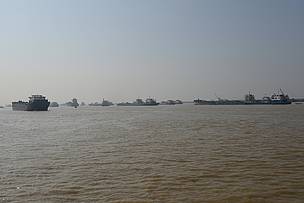
Newsroom
Shipping, Overfishing Pushing Yangtze Finless Porpoise towards Extinction
Wuhan, China – The number of endangered finless porpoise spotted in an ongoing research expedition along the Wuhan-Yichang section of the Yangtze River has declined drastically with growing evidence pointing to impact of shipping and overfishing pushing the rare animal towards extinction, scientists on the expedition say.

Cargo vessels are seen in the waters off Chenglingji port in Hubei. Busy commercial shipping traffic could have an impact on the survival of the Yangtze finless porpoise, scientists say. (Photo by IHB)
The survey team has visually identified 39 individuals of the Yangtze finless porpoise – endangered on the IUCN Red List – during the 1,252km round-trip voyage on Wuhan-Yichang-Wuhan section of the river.
"Based on visual and sonar identification, the number of the Yangtze finless porpoises we've spotted is about one-third of the detected in the area during a similar study six years ago," said Wang Kexiong, deputy head of the research expedition and an associate researcher at the Institute of Hydrobiology, Chinese Academy of Sciences(IHB).
Most of the 39 finless porpoises were spotted in the waters close to the Yanshou Dam, near the city of Yichang, Gong'an county, Chenglingji and Luoshan.
The distribution became concentrated and its location moved up stream compared to results in 2006, when the majority of discoveries were made across a wider area.
"The changes could be attributed to the comparatively gentle flow and rich fishery resources in waters near Yanshou Dam and Gong'an," said Wang.
The Yangtze finless porpoise (Neophocaena phocaenoides asiaeorientalis), which numbers between 1,200 to 1,500 in the wild, lives mainly in the central and lower reaches of the 6300km Yangtze River and two large adjoining lakes, Dongting and Poyang. Recent studies say that the species could become extinct in 15 years if nothing is done to protect them.
The expedition team is due to depart Wednesday for Shanghai before heading back to Wuhan late next month when the initial results of the research are expected to be announced.
Calculation of the number of cargo and fishing ships in the Yangtze started from Yichang onward to evaluate the pressure posed by shipping and fishery activities on the endangered species.
"Shipping traffic and fishing activities can cast an influence on the survival of the Yangtze finless porpoises. The relatively concentrated distribution and fixed location could possibly result from excessively busy shipping traffic in certain sections of the river that may have severed route of communication of the porpoises," said Zhang Xinqiao, expedition team member and WWF finless porpoise programme officer.
For instance, in the waters off Shijitou in Xianning and Hannan district of Wuhan that have the busiest traffic of fishing and cargo shipping so far, little traces of porpoises were detected, said Zhang.
A total of 80 fishery boats and 697 cargo ships were counted by the team from Yichang-Wuhan. Twenty-seven cargo ships were calculated within 30 minutes in the waters off the Hannan district of Wuhan, while the number in Shijitou stood at six.
Led by China's Ministry of Agriculture and organized by the IHB, WWF and Wuhan Baiji Dolphin Conservation Fund, the expedition commenced on November 11 and comes only six years after the Baiji dolphin - another rare cetacean and close relative of the finless porpoise - was declared functionally extinct. (WWF)